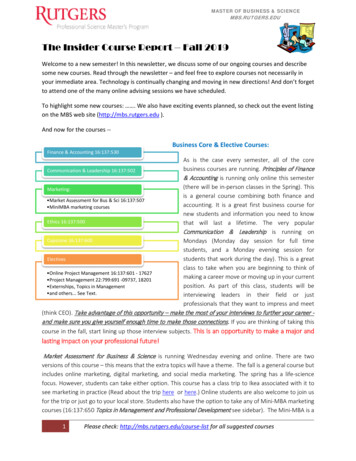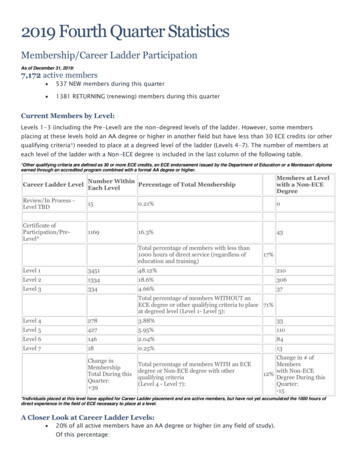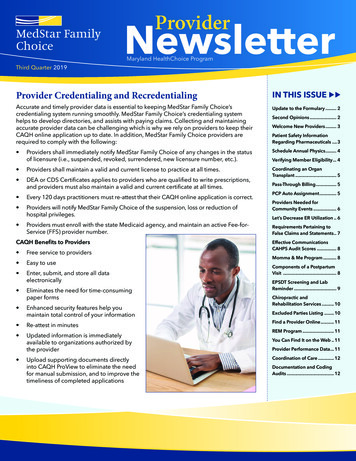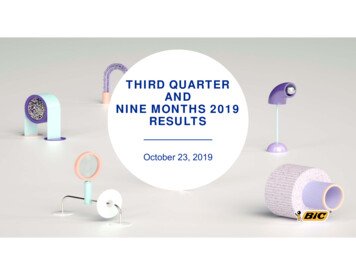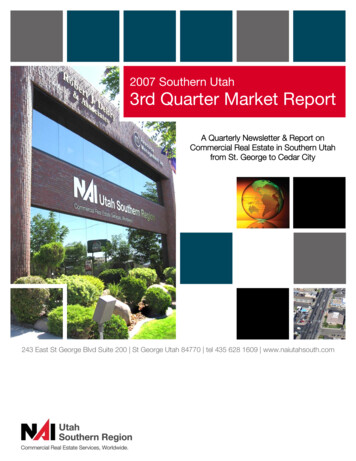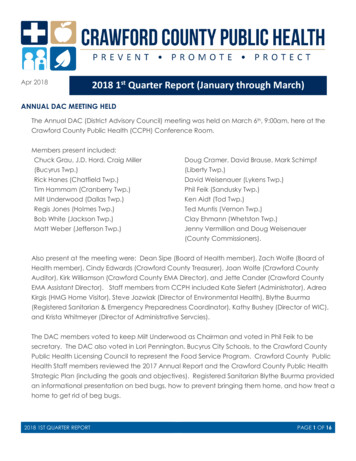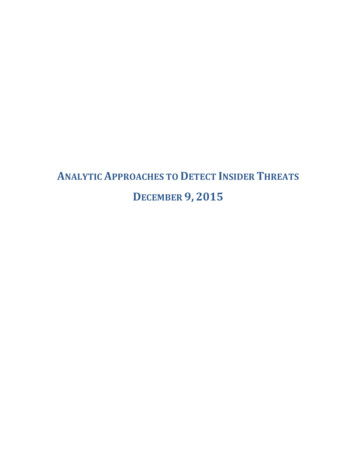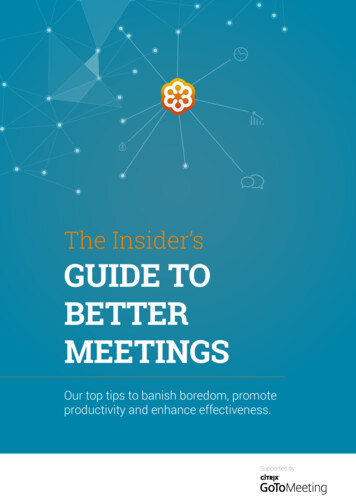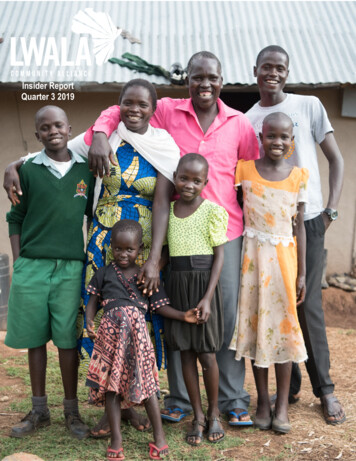
Transcription
Insider ReportQuarter 3 20191 Insider Report Q3 2019
Letter from the DirectorsDear Insiders,This quarter, our leadership has seized several opportunities to share our model on a global stage. Indeed,the transformational impact we are seeing in rural Kenya has implications for the larger movement forhealth equity. This effort is important to our mission as it builds on the long-term goal of reforming thesystems responsible for many of the health and development challenges our communities face.In these global forums we have joined forces with peers and collaborators who share our values forcommunity-driven development and health justice. Together, our voices are amplified.For example, we joined the Community Health Impact Coalition at the sidelines of the United NationsGeneral Assembly (UNGA) to advocate for the use of the CHW AIM tool, a document co-authored byLwala’s Executive Director. We presented to representatives from USAID, WHO, Ministries of Health,and large funders on Lwala’s use of the tool to inform Migori County’s community health strategy.At a TED event, Lwala was featured in a film about the movement to design better community healthsystems with Community Health Workers at their core. Our Managing Director spoke eloquently aboutthe challenge to reach the 1 billion people left out of formal health systems and how Community HealthWorkers can close the gap. He joined voices from our close collaborators at Last Mile Health, LivingGoods, Medic Mobile, and Financing Alliance.You’ll read more examples of this global reach in this report. And, you’ll learn about the tangible ways ourwork is advancing on the ground.This quarter, we greatly accelerated our work in Water, Sanitation & Hygiene, with 41 new villagesdeclared Open Defecation Free by the Ministry of Health. This is the culmination of years of communityled advocacy and the construction of hundreds of latrines. It means we’ll see a reduction in water-borneillnesses, especially benefiting children and people living with HIV.We also saw big payoffs in our work with government health facilities. After investing in community-ledHealth Facility Management Committees and intensive quality improvement cycles, we saw facilitiesimproving patient satisfaction scores, strengthening supply chains for essential commodities, andsecuring government reimbursements allowing them to invest in patient care.We are inspired by the creativity and drive of our communities and believe they hold the keys totransform systems of inequity. Thank you for being part of this bottom-up movement!In solidarity,Ash RogersJulius Mbeya2 Insider Report Q3 2019
Table of ContentsOUR IMPACT 4Systems Change .4Quality Improvement .6Community Health Workers 9Maternal Health .11Child Health .13Nutrition .13Sexual and Reproductive Health .14HIV and WASH Integrated Care (HAWI) 16Lwala Community Hospital 17Education .19Economic Empowerment .21Measurement & Research .22Leadership .23OUR MODEL .25Health Systems Strengthening .25Quality Improvement .27Community Health Workers .29Maternal Health .29Child Health .30Nutrition .31Sexual and Reproductive Health .31HIV and WASH Integrated Care (HAWI) 33Lwala Community Hospital 34Education .35Economic Empowerment .37Measurement .37STAFF SPOTLIGHT .39BENEFICIARY STORY 403 Insider Report Q3 2019
Our ImpactSYSTEMS CHANGE 1Global Engagement1Our Lwala continues to play an active role in the Community Health Impact Coalition (CHIC), acoalition of 13 leading expert organizations implementing Community Health Worker modelsaround the world. Together with the coalition, Lwala has co-authored several tools on optimizingcommunity health systems that have been published and made available to a global audience. As part of CHIC, Lwala co-authored USAID & UNICEF’s AIM tool, which outlines standards forquality Community Health Worker implementation. At a UN General Assembly side-line event,Lwala presented our example of using the AIM tool to support county-level policy. The audienceincluded representatives from USAID, WHO, Ministry of Health, and several high-profilebilateral and multilateral funders. Lwala again presented on the AIM tool at the CORE Group’sGlobal Health Practitioner Conference in Nairobi. CHIC is pioneering a prototype dashboard of 9 key community health indicators as a collaborativeeffort to improve community health outcomes that lead to quality care delivery. After an initialround of indicator mapping, Lwala’s community-led model and Kenya-specific context isinstrumental in ongoing discussions on how to strengthen data collection around theseindicators. Once piloted, this collective data dashboard will serve as a tool to analyze trends andcollect community health data across implementers all over the world.model for Health Systems Strengthening is on page 25.4 Insider Report Q3 2019
Lwala is leveraging our expertise on maternal and child healthcare to provide technical assistanceto peer institutions such as UGEAFI and SACODE from Burundi and Harvest Initiatives andNundu Deaconess Hospital in the Democratic Republic of the Congo. These groups came toKenya for a learning visit this quarter and Lwala will support these organizations in implementingand sustaining effective antenatal care and skilled delivery surveillance based on Lwala’scommunity-led health model. Lwala is supporting Komo Learning Centers in Uganda by providing technical assistance tovillage health teams to replicate our community-led health model. This collaboration presentsanother opportunity for Lwala to use its expertise in community-led healthcare to support otherorganizations, while we continue to grow and learn from others.National Influence In the pursuit of Universal Health Coverage, Lwala is a key player collaborating on the newCommunity Health Strategy 2020-2025 in partnership with the National Ministry ofHealth. Lwala is informing the development of the strategy by actively participating in technicalworking groups on community health, maternal child health, and sexual and reproductive health.We are pushing for the inclusion of several components of Lwala’s successful community-ledhealth model such as the payment of Community Health Workers and their inclusion into theformal health system. As a part of the National Reproductive Maternal Neonatal and Child Health team’s technicalworking group, Lwala is pushing for the inclusion of the non-pneumatic anti-shock garment(NASG) into the national Emergency Obstetric Care Curriculum to be implemented in everyfacility Kenya. The NASG is a low-tech tool perfectly suited to treat obstetric hemorrhage in ruralcommunities. This commitment would require the Ministry of Health to include the NASG as anessential commodity distributed to every facility. This would ensure that every woman can accessthis life-saving technology, regardless of the region in which she delivers. Lwala is engaging in discussions with the national government around how to best develop acomprehensive primary health strategy in Kenya. Currently, the national Primary Health CareStrategy is undergoing significant changes driven by the internal restructuring and merging ofseveral different public health departments at the Ministry of Health. Lwala is drivingconversations around implementation of quality community health services by CommunityHealth Workers as a key component of primary health care. Community participation in primaryhealth care provision is essential for achieving Universal Health Coverage. Lwala facilitated a session on innovative product development during Innovations inHealthcare’s Venture4Change bootcamp. As an innovative implementer, Lwala showcasedits community-led Water, Sanitation, and Hygiene (WASH) program to students from KenyattaUniversity interested in the implementation, launch, and scale of WASH innovations.Regional Advisement Lwala is a part of the technical working group for the the Inter-County Coordinationmechanism for Human Resources for Health. Lwala has been collaborating with 6counties in the Lake Victoria Region, representing 6 million people, to formalize the roles ofCommunity Health Workers into the healthcare system. Lwala is pushing for the members of thisgroup to recognize Community Health Workers as formal healthcare providers through paymentand supervision. Lwala trained 6 high-volume facilities in the Lake Victoria region on the NASG for obstetrichemorrhage management. These facilities will join the 17 facilities in Migori County that Lwalatrained to use the garment to treat obstetric hemorrhage and prevent maternal death.5 Insider Report Q3 2019
County Collaboration Lwala is partnering with Kisumu Medical EducationTrust (KMET) and the Ministry of Health to roll-out anObstetric Hemorrhage Bundle. Created by the WorldHealth Organization, the bundle includes a number ofinterventions to treat obstetric hemorrhage includingmisoprostol, uterine balloon tamponade, the nonpneumatic anti-shock garment, and more. The Migori County government recently reorganized thepublic health department, most notably by creating anew Chief Officer of Health position. With this newposition created, there will be greater governmentattention paid to Community Health Workers. Lwalawill play a key role by using our evidence-basedexpertise to support the new Chief Officer of Health withtechnical assistance and tools to implement bestpractices for community-led health models Lwala is a key player providing research and technicalassistance to the county as they draft the CountyCommunity Health Services Bill for Migori County.As an expert implementer of a community-led healthmodel, Lwala has been advocating for innovativefinancing strategies, quality community health services,additional capacity trainings for Community Health Workers, and robust data collection systemsas integral components of effective community health systems. The law’s legal framework iscomplete, and the draft is at the county parliament level for approval.Sub-County Implementation We are successfully providing direct services in 2 out of the 4 sub-locations – North Kamagambo(our innovation hub) and East Kamagambo (our first expansion site). We have made significantimpact on health outcomes since we expanded to our first expansion site in mid-2018. Weattribute this success to our thorough community entry strategy that includes householdmapping, recruitment of traditional midwives, discussions with key community stakeholders,community-driven recruitment of Community Health Workers, and our close partnership withthe Ministry of Health who co-implements every step of this process. Our expansion efforts aredone this way to intentionally reinforce our belief in community-driven change. We are preparing to expand into our second expansion site, South Kamagambo, by conductingkey community entry activities including Community Health Worker capacity trainings andfunctionality assessments. Before entering into South Kamagambo, where we will bring our directreach to 90,000 people, we have undertaken significant technology systems updates that willdirectly align our Community Health Worker data collection structure to that of the Ministry ofHealth. With this revised structure, the Ministry of Health will easily be able to capture the fullbreadth of impact that Lwala’s community-led health model has on frontline healthcare.QUALITY IMPROVEMENT 2 2OurOur partner facilities achieved a 14% average increase in QI Index scores on the HealthFacility Assessment compared to their respective baselines. This is a 7% increase from theprevious assessment. Kochola Dispensary achieved a 20% increase from the previous assessment,which is the largest increase yet! Ngere and Ndege Oriedo’s index scores increased by 12% andmodel for Quality Improvement is on page 27.6 Insider Report Q3 2019
11% respectively. The actions taken by the Health Facility Management Committees in these 2facilities to achieve these increases are described below. Average adherence to clinical standards across all 7 facilities is now at 87%, animprovement of 17% from the baseline assessment. Staff members from partner facilitiesimprove in their clinical skills through direct Clinical Mentorship as well as throughparticipation in our Clinical Staff Rotation program.oThis quarter, Lwala’s Nurse Mentor and Quality Improvement Officer provided 123direct mentorship sessions while observing the work of 35 staff across 7 partnerfacilities. Mentorship sessions included monitoring adherence to clinical standards andreal-time skills development. Case observations help our quality improvement teamidentify service areas that need strengthening at each facility. The graph below showsclinicians’ adherence to clinical standards at each of our 7 partner facilities. Thestandards against which they are measured were adapted from Kenya national standardsand standards from global bodies such as the WHO.Clinical Standards Adhered a77%80%70%60%50%40%30%20%10%0%o LwalaKangeso MinyenyaNgere8 staff members have participated in our Clinical Staff Rotation program. Inaddition to our direct mentorship sessions, this staff rotation program is another methodby which the gaps in clinical standard adherence are addressed. During each rotation, aclinician from a partner facility switches places with a Lwala staff member for a 2-weekperiod to learn about and implement best practices at the facility they are visiting. Theythen bring those lessons back to their own facilities and support continued improvementwith their colleagues.Since last quarter, data accuracy has improved by an average of 7% across our 7partner facilities. Lwala is collaborating with county data assurance teams to eliminateduplication of efforts and enable a more complete understanding of data accuracy. This will allowus to better target weak areas and build upon these improvements even more.oWe completed an in-depth analysis on our Data Quality Audit (DQA) results fromQ2. We altered our analysis approach to focus on facility-specific data accuracy as thecore indicator. By comparing aggregated facility data to both government data anddisaggregated facility data, we were able to find the variance between data reports and7 Insider Report Q3 2019
ultimately calculate data accuracy. In Q1, DQA scores were calculated by looking at dataaccuracy across a standard list of indicators. However, we found that this disadvantageslower volume facilities that do not report on indicators for which they do not provideservices. Health Facility Management Committees at all 7 partner facilities led trainings for their staff onthe Linda Mama government reimbursement program. As a result, all 7 partner facilities arenow enrolled in the Linda Mama program and have obtained their Linda Mama facilitycodes. This process was required to receive reimbursements for services facilities had alreadybeen providing. With all staff now trained on the process of enrollment, registration, andreimbursement for the Linda Mama program, the facilities will receive reimbursements theyweren’t receiving previously. This positions the Health Facility Management Committees to usethe reimbursements as discretionary income to be spent on additional salaries for new staffmembers and more clinical supplies. There was a 7% increase in overall patient satisfaction scores from our 7 partnerfacilities. There was a 15% average increase across the 7 facilities for patientlikelihood to refer others to the facility. Suggestions and comments taken from patients duringthe patient satisfaction surveys help inform priority areas for facility work improvement plans.Patient Likelihood to a60%50%LwalaQuarter 1 (2019)o99%77%Ngere99%86%92%97%93%76%NgodheNdege OriedoKocholaQuarter 2 (2019)At Ndege Oriedo Dispensary, the most recent patient satisfaction survey showed a 16%increase in patient likelihood to refer others to the facility. The Health FacilityManagement Committee at Ndege Oriedo held dialogue days in the community to createa forum for community members to share the reasons why they would not refer thefacility to others. Community members noted that the staff at the facility were notparticularly welcoming. In Kenya, staff are frequently rotated around governmentfacilities as directed by the Ministry of Health. This quarter, Ndege received 2 new staffmembers. The Health Facility Management Committee used this as an opportunity torespond to the comments raised by the community during the dialogue days bythoroughly orienting new staff on offering respectful and quality care. In the staffsatisfaction survey from quarter 2, patients noted that new staff at the facility wereparticularly engaging, which encourages patients to return for future visits.8 Insider Report Q3 2019
We completed work improvement plans across our 7 partner facilities with a focus oninfrastructure development and workload management. Successes from these work improvementplans include:oSince the beginning of 2019, Kangeso Dispensary has not had a consistent supply ofelectricity. The Health Facility Management Committee proactively approached the localadministrative office, local parliament, and even the office of the governor to raise theirconcerns, but no action was taken. Instead of waiting idly, the Health FacilityManagement Committee put pressure on the power company until the facility was finallyconnected to the power grid this quarter. Now, the facility is able to provide high quality,24-hour services.oAt Ngere Dispensary, the workload has recently increased. Community Health Workershave been providing high-quality community-based services and referring patients toNgere for advanced care, creating increased health seeking behavior. However, Ngere’sphysical infrastructure could not sustain the patient caseload. In response, the HealthFacility Management Committee at Ngere decided to repurpose one of the staff quartersas an extension of the maternal and postnatal wards. The staff quarters had 4 bedrooms,a kitchen, and a large living area but was occupied only by one person. The occupantretained one of the bedrooms, and the facility was able to create more space for patients.There are plans to use some of the additional space to house a youth-friendly corner.COMMUNITY HEALTH WORKERS 3 24,860 clients are enrolled in our Community Health Worker program, 1,114 of whom wereenrolled this quarter. They are regularly monitored by a Community Health Worker through ourpatient-centered health database. The customized database stores data delivered by CommunityHealth Workers in real time to inform evidence-based decision-making and responsive healthsurveillance.Individuals Enrolled in CHW ProgramTotal YTD: 24860No. of 01600014000120001000080006000400020000North TT5 mothers (5169)North TT5 children (7539)East TT5 mothers (3671)East TT5/HAWI mothers(282)3OurNorth HAWI individuals (1397)East TT5 children (4109)East HAWI individuals (1
Kenya for a learning visit this quarter and Lwala will support these organizations in implementing and sustaining effective antenatal care and skilled delivery surveillance based on Lwala’s community-led health model. Lwala is support
